 |
Experimental
and numerical investigations
of mechanisms in unsaturated geomaterials
|
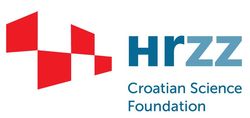 |
This project was funded by the Croatian Science Foundation under the number UIP-2017-05-3429.
The project was also co-financed by FCEAG in the amount of 15% of the HRZZ's participation.
Research team members are grateful for support.
|
Project Summary
Weathering as rock degradation under the direct influence of environmental conditions and human activity in the engineering period of time, is a key process that affects geomorphologic, ecologic and societal processes and events. Soft rocks, such as marl, are very common in the Mediterranean and particularly susceptible to weathering. This is manifested through the decomposition of the binder from clayey rock structure and breaking of the rock structure due to physical and chemical processes. Under such influence, weathering degrades soft rocks to fine-grained material, which is related to environmental sustainability (erosion, climate change issues, slopes, rock falls and other geohazards), stability, bearing capacity and durability issues (temporal change of strength and deformability).
According to recent scientific findings, a significant contributor to the development of weathering is the process of differential suction and induced differential swelling, which occurs in unsaturated conditions. Differential suction comes as a result of capillary effects in voids of the material and it is closely related to slaking of the material. The consequences of differential swelling are development of tensile and shear stresses that cause weathering. Therefore, the aim of this project is to investigate and simulate the mechanisms of weathering from the aspect of suction, and to link the acquired new findings with the significant previous research carried out at the Faculty.
The shear strength and deformability in unsaturated conditions for the given degree of suction, and the characteristic SDSWCC curves (Stress Dependent Soil Water Characteristic Curve) will be determined by sophisticated testing equipment on still unexamined soft rock material from the Croatian coastal area (flysch marls with varying calcium carbonate content). At the same time all “accompanying” tests, including physical, mechanical, mineralogical and petrological, will be carried out and new and existing databases will be linked. Full experimental programme will be carried out on approximately 30 specimens. The unsaturated tests will primarily be conducted using the axis translation technique in suction oedometer with CRS (Constant Rate of Strain) Unsat cell by GDS Instruments. Additionally, other test methods and equipment will be used in accordance with new skills and knowledge gained through international collaborations.
The obtained results will be incorporated into the existing numerical model (Plaxis) and into additionally developed new numerical model based on a discrete approach, which will include the fracture mechanism in geomaterials in unsaturated flow conditions. This will significantly improve the knowledge of weathering mechanisms in geomaterials and enable sustainable project solutions.
A newly formed research group with the necessary resources provides additional value of the project.
Project Team
Team members:
- Assoc. prof. Nataša Štambuk Cvitanović
- Assist. prof. Mijo Nikolić
- Assist. prof. Goran Vlastelica
- Ana Duhović, MCEng, PhD student
- Prof. Predrag Miščević (associate/consultant)
- Stipe Rađa, technician
Assoc. prof. Nataša Štambuk Cvitanović, PhD, principal investigator of the project, is an expert and researcher in the field of geotechnical engineering. She is engaged in scientific research work and solving problems related to geotechnical investigations and design using in situ and laboratory parameters, especially soil and rock mechanics, and laboratory/field testing, observations and research.
Assist. prof. Mijo Nikolić, PhD, a researcher on the project, deals with the development of numerical models (e.g. finite element method with embedded discontinuities) and their application in the rock and structural mechanics (fracture mechanisms under various flow and other conditions).
Assist. prof. Goran Vlastelica, PhD, a researcher at the project, deals with geotechnical researches, in particular the problems of soft rock in terms of weathering (degradation), changes of properties in time and stability/durability of cuts in flysch.
Besides the FCEAG researchers from the University of Split, this Project includes researchers from other institutions in Croatia and abroad:
- FCGE Ljubljana (University of Ljubljana, Faculty of Civil and Geodetic Engineering, Slovenia): Assoc. Prof. Ana Petkovšek, PhD; Assist. Prof. Matej Maček, PhD; Jasna Smolar, PhD
- IST DECivil Lisbon (University of Lisbon, Department of Civil Engineering, Architecture and Georresources, Portugal): Assoc. Prof. Rafaela Cardoso, PhD
- FCE Rijeka (University of Rijeka, Faculty of Civil Engineering): Josip Peranić, PhD; Assist. Prof. Vedran Jagodnik, PhD
- BUTE Budapest (Budapest University of Technology and Economics, Department of Engineering Geology and Geotechnics, Budapest, Hungary): Assoc. Prof. Péter Görög, PhD; Prof. Ákos Török, PhD
- GG Kiel: (Geomechanics and Geotechnics, Kiel University, Kiel, Germany): Zarghaam Haider Rizvi, PhD
- FMGPE Zagreb (University of Zagreb, Faculty of Mining, Geology and Petroleum Engineering): Prof. Biljana Kovačević Zelić, PhD; Michaela Hruškova Hasan, PhD
Project Goals
- Literature review and expand of the current knowledge
- Establish a research group and laboratory for unsaturated soil
- Provide appropriate initial (introductory) experimental and numerical research with appropriate dissemination and training, and determine the final testing methodology and usability of available software (Plaxis)
- Carry out main experimental and numerical research of mechanisms in unsaturated geomateriaals (suction, degradation) using the example of soft rock (full test program on marl samples) and develop a new numerical model that can include the fracture mechanism in unsaturated flow conditions
- Based on the acquired findings, through further training and dissemination improve the knowledge of the behavior of unsaturated geomaterials; link the current and new research (unique database) and establish criteria for using suction as part of laboratory and field research
- Submit project proposals from the research group to other sources of funding
Activities
- Analysis of additional literature and update/analysis of the existing database (2018)
- Procurement computers and software (Plaxis) for initial numerical investigations (2018); Procurement of a laptop computer (2019) and maintenance of software necessary for further numerical analyses (2019-2022)
- Training at Faculty of Civil and Geodetic Engineering in Ljubljana on the topic of laboratory and field tests of suction and significance of soil water characteristic curve (SWCC) (2018, 2020), and at the Faculty of Civil Engineering, Transportation Engineering and Architecture in Maribor (special types of triaxial tests, 2023)
- Procurement, installation and commissioning of advanced research equipment for testing in unsaturated conditions – automatic suction oedometer, manufacturer GDS Instruments (2018), and the WP4 device ("WP4C Water Potential Meter") for determining suction and SWCC (Soil Water Characteristic Curve) using the dew point method (2021)
- Synthesis and dissemination of the preliminary findings - paper published at the XVII European Conference on Soil Mechanics and Geotechnical Engineering in Reykjavik, Iceland (2019)
- Performing a public tender for recruiting an PhD candidate (2018 and repeated in 2019)
- Servicing and calibration of existing equipment used in research (2018, 2019, 2021)
- Supply of materials needed for testing (2018, 2019, 2020)
- Sampling (exploration pits) for initial tests and continuously (2018-2022); Sampling (exploratory drilling) for further research (2020)
- Initial laboratory tests (FCEAG Split, FCE Rijeka and Croatian Geological Survey Zagreb) and analysis of results – established methodology for experimental research (2018/2019)
- Initial numerical research in Plaxis for unsaturated conditions and phase verification in model development - paper published in the journal Granular Matter (2018/2019)
- Implementation of test results in Plaxis – analysis of the possibilities and restrictions of Plaxis models, guidelines for further experimental and numerical research (2019); research paper on numerical simulation of saturated and unsaturated one-dimensional consolidation tests performed on reconstituted marl samples using Plaxis software in International Journal for Engineering Modelling (2021)
- Development of the new numerical model and dissemination: participation at the international conference ECCOMAS/CM4P “Computational Methods in Multi-scale, Multi-uncertainty and Multi-physics Problems”, Porto 2019 (abstract and presentation, 2019)
- Conduction of the main laboratory tests and the continuance of the unsaturated research on marl samples with implementation of new test methods through international collaborations (IST DECivil Lisbon, FCGE Ljubljana) (2019/2020). Except suction oedometer (axis translation method, Split), new test methods include: WP4 apparatus – dew point potentiometer (Lisbon, Ljubljana), HYPROP apparatus (Ljubljana), vapour equilibrium method (Lisbon), Enslin – Neff method for water adsorption capacity (Ljubljana), Methylene Blue surface area method (Ljubljana). Analysis of the results and correlation with other test results.
- Implementation of new test methods at FCEAG Split: vapour equilibrium method, Methylene Blue surface area method and Enslin-Neff method for water adsorption capacity (2021); dew point method using WP4 device (2021)
- Conduction of other planned tests (physical, mechanical, mineralogical and chemical) at FCEAG Split and FMGPE Zagreb (2019-2023)
- Establishment of new international collaborations – IST DECivil Lisbon and BUTE Budapest, in addition to FCGE Ljubljana and CG Kiel. As a result of BUTE Budapest collaboration, an article for the 6th International Conference on Geotechnical and Geophysical Site Characterization – ISC6 (Budapest, Hungary 2021) has been accepted.
- Development of a novel 2D numerical model for unsaturated analysis i.e. for simulations of cracking and failure of geomaterials under the unsaturated flow (2019-2021); model development was completed in February 2021 and a corresponding paper was published in the journal Computer Methods in Applied Mechanics and Engineering (2022)
- Application of the project proposal by a member of the research group to other sources of funding (Assist. Prof. Mijo Nikolić, PhD, application of the new HRZZ project, 2020; project UIP-2020-02-6693 accepted for funding)
- Students' research and works related to the project: 3 MSc theses and one BSc thesis (2021), and one PhD thesis (in progress, accepted topic of the doctoral thesis in 2022)
- Final research at FGAG Split by combining several methods and new equipment – testing and modeling SWCC/SDSWCC for marls in intact and reconstituted state and researching the connection between suction and wethering by testing SWCC of marly material in different stages of laboratory simulated weathering (2021-2023)
- Application of acquired knowledge: connection of suction and the appearance of rockfalls (conference paper, Athens, 2021), and suction and the formation of a large number of new sinkholes after the earthquake of December 29, 2020 near Petrinja (paper at the congress, USA, 2021; paper published in the journal Earthquake Spectra, 2022/2023; paper at the conference 2CroCEE - 2nd Croatian Conference on Earthquake Engineering, 2023; paper at the 9th Conference of Croatian Geotechnical Society, 2023)
- Linking databases and analysis of marl properties: paper in the journal Symmetry, 2022
- Promotion of conducted research and further participation in congresses: 10th ICCSM - International Congress of Croatian Society of Mechanics (new numerical model, 2022); 5th Symposium of the Macedonian Association for Geotechnics (experimental students’ research related to the project, 2 papers, 2022)
Publications
- Rizvi, Z. H. Nikolić, M. Wuttke, F. Lattice element method for simulations of failure in bio-cemented sands. Granular Matter 21, 18 (2019) https://doi.org/10.1007/s10035-019-0878-6
- Nikolic, M. Ibrahimbegovic, A. Modelling of shear bands in fluid saturated poroplastic solids with embedded strong discontinuities. Proceedings of CM4P - Eccomas Thematic Conference – Computational Methods in Multi-scale, Multi-uncertainty and Multi-physics Problems. Porto, Portugal (2019) https://www.bib.irb.hr/1024920
- Vlastelica, G. Štambuk Cvitanović, N. Miščević, P. Nikolić, M. Raič, A. The role of unsaturated condition and suction in the weathering mechanisms in flysch marls. XVII European Conference on Soil Mechanics and Geotechnical Engineering Proceedings. Reykjavik, Iceland (2019) doi: 10.32075/17ECSMGE-2019-0878; https://www.bib.irb.hr/1021187
- Raič, A. Štambuk Cvitanović, N. Vlastelica G., Török, A. Görög, P. Marly soft rocks from Dalmatia (Croatia) and Budapest (Hungary) – correlation of intact rock physical and mechanical properties. Proceedings of ISC'6 - 6th International Conference on Geotechnical and Geophysical Site Characterization. 26-29 September 2021, Budapest, Hungary (paper ID: ISC2020-196). http://isc6.org/images/Cikkek/Sessions/ISC2020-196.pdf; https://www.bib.irb.hr/1176311
- Raič, A. Štambuk Cvitanović, N. Vlastelica, G. The effect of suction on differential weathering and stability of soft rock cliffs on the example of Zenta Bay cliff (Split, Croatia). Proceedings of EUROENGEO - 3rd European Regional Conference of IAEG - Leading to Innovative Engineering Geology Practices. 7-10 October 2021, Athens, Greece; Volume 1, Extended abstracts, 193-194. https://euroengeo2020.org/wp-content/uploads/2021/10/PROCEEDINGS-ABSTRACTS_20211014.pdf; https://www.bib.irb.hr/1176638
- Raič, A. Nikolić, M. Štambuk Cvitanović, N. Galić, M. Numerical simulation of saturated and unsaturated consolidation behaviour of marl residual soil. International Journal for Engineering Modelling 34 (2021) 1, 31-47. doi: 10.31534/engmod.2021.1.ri.03b
- Tomac, I. Vlahović, I. Parlov, J. Matoš, B. Matešić, D. Kosović, I. Pavičić, I. Frangen, T. Terzić, J. Pavelić, D. Kovačević Zelić, B. Perić, D. Domitrović, D. Vučenović, H. Štambuk Cvitanović, N. Pham N. Extensive Post-Seismic Cover-Collapse Sinkhole Opening During 2020–2021 Petrinja Earthquake Sequence (Croatia): a Unique Local Geological, Geotechnical and Hydrological Setting. Proc. of American Geophysical Union Fall Meeting, 13-17 December 2021, New Orleans, LA & Online Everywhere. https://agu2021fallmeeting-agu.ipostersessions.com/Default.aspx?s=DF-AD-26-27-6C-B8-5A-4C-69-2A-2F-8B-71-49-BB-FC&pdfprint=true&guestvie%E2%80%A6; https://www.bib.irb.hr/1165513
- Nikolic, M. Discrete element model for the failure analysis of partially saturated porous media with propagating cracks represented with embedded strong discontinuities. Computer Methods in Applied Mechanics and Engineering 390 (2022) 114482. https://doi.org/10.1016/j.cma.2021.114482
- Tomac, I. Kovačević Zelić, B. Perić, D. Domitrović, D. Štambuk Cvitanović, N. Vučenović, H. Parlov, J. Stipčević, J. Matešić, D. Matoš, B. Vlahović, I. Geotechnical reconnaissance of an extensive cover- collapse sinkhole phenomena of 2020–2021 Petrinja earthquake sequence (Central Croatia). Earthquake spectra 39 (2023) 1, 653-686. https://journals.sagepub.com/doi/pdf/10.1177/87552930221115759
- Relota, M. Duhović, A. Vlastelica, G. Analiza globalne stabilnosti zasjeka unutar napuštenog gradilišta: primjer sa lokacije u Bračkoj ulici u Splitu / Analysis of the global stability of cut slope within an abandoned construction site: an example from the Bračka Street location in Split (Croatia) (in Croatian). Proc. of Engineering problems in soft rocks - 5th Symposium of the Macedonian Association for Geotechnics. 23-25 June 2022, Ohrid, North Macedonia; Volume 1, Skopje: Macedonian Association for Geotechnics, 2022, 264-273. https://drive.google.com/file/d/1MHfRdn2mtUSwSNxrC6ySfYinBeXv2rmv/view
- Duvnjak, S. Duhović, A. Vlastelica, G. Laboratorijska ispitivanja fizičko-mehaničkih svojstava lapora za potrebe proračuna slijeganja jednostavnog homogenog nasipa / Laboratory tests of the physical-mechanical properties of marl to determine the settlement of a simple homogeneous embankment (in Croatian). Proc. of Engineering problems in soft rocks - 5th Symposium of the Macedonian Association for Geotechnics. 23-25 June 2022, Ohrid, North Macedonia; Volume 1, Skopje: Macedonian Association for Geotechnics, 2022., 363-371. https://drive.google.com/file/d/1MHfRdn2mtUSwSNxrC6ySfYinBeXv2rmv/view
- Nikolić, M. Fully coupled hydro-mechanical model for failure of unsaturated soils and desiccation cracking. Proc. of 10th International Congress of Croatian Society of Mechanics. 28-30 September 2022, Pula, Croatia; Croatian Society of Mechanics (HDM), 2022, 209-210 (extended abstract).
- Duhović, A. Štambuk Cvitanović, N. Vlastelica, G. Török, Á. Görög, P. Marly Soft Rocks: Correlation of Physical and Mechanical Properties—Examples from Dalmatia (Croatia) and Budapest (Hungary). Symmetry, 2022 (2022) 14; 2170, 19. https://doi.org/10.3390/sym14102170
- (GEER) Tomac, I. Kovačević Zelić, B. Perić, D. Domitrović, D. Štambuk Cvitanović, N. Vučenović, H. Parlov, J. Stipčević, J. Matešić, D. Matoš, B. Vlahović, I. Geotechnical reconnaissance of cover-collapse sinkhole area following Petrinja 2020 earthquake. Proc. of 2nd Croatian Conference on Earthquake Engineering - 2CroCEE. 22-24 March 2023, Zagreb, Croatia; University of Zagreb, Faculty of Civil Engineering, 2023. 57-68. https://doi.org/10.5592/CO/2CroCEE.2023.84
- Kovačević Zelić, B. Domitrović, D. Štambuk Cvitanović, N. Perić, D. Vučenović, H. Parlov, J. Matešić, D. Matoš, B. Vlahović, I. Tomac, I. Geotechnical site characterization of the biggest cover-collapse sinkhole in Mečenčani village following 2020 Petrinja earthquake. Proc. of 9th Conference of Croatian Geotechnical Society. 4-6 May 2023, Sisak, Croatia; Zagreb: Kerschoffset Zagreb, 2023, 141-148.
Papers in the process of publication
- Duhović, A. Štambuk Cvitanović, N. Experimental study on water retention behaviour of Eocene flysch marls from the region of Dalmatia (Croatia). Bulletin of Engineering Geology and the Environment, 2023.
Photo Gallery

Kick-off meeting 21/03/2018

Field trip to Slano Blato landslide in Slovenia (18/10/2018); A. Petkovšek (FCGE Ljubljana) i N. Štambuk Cvitanović (FCEAG Split) near the deep reinforced concrete dowels (shafts) constructed for mitigation of the landslide

Family of Soil Water Characteristic Curves (SWCC) with the marked range of examined marls; wPI value – a product of the percentage of particles below 0.075 mm (decimal value) and plasticity index (%) (adapted from Zapata et al., 2000)


Degradation mechanism: differential swelling caused by suction gradients (from Cardoso, 2009) and an example of degradation caused on marl sample by suction

Installation of automatic suction oedometer

New automatic test equipment: load frame, sample cell, pressure/volume controllers for water and air, data logger with connected force, axial displacement, pore water pressure and air pressure transducers

Measurement results of volume changes under suction
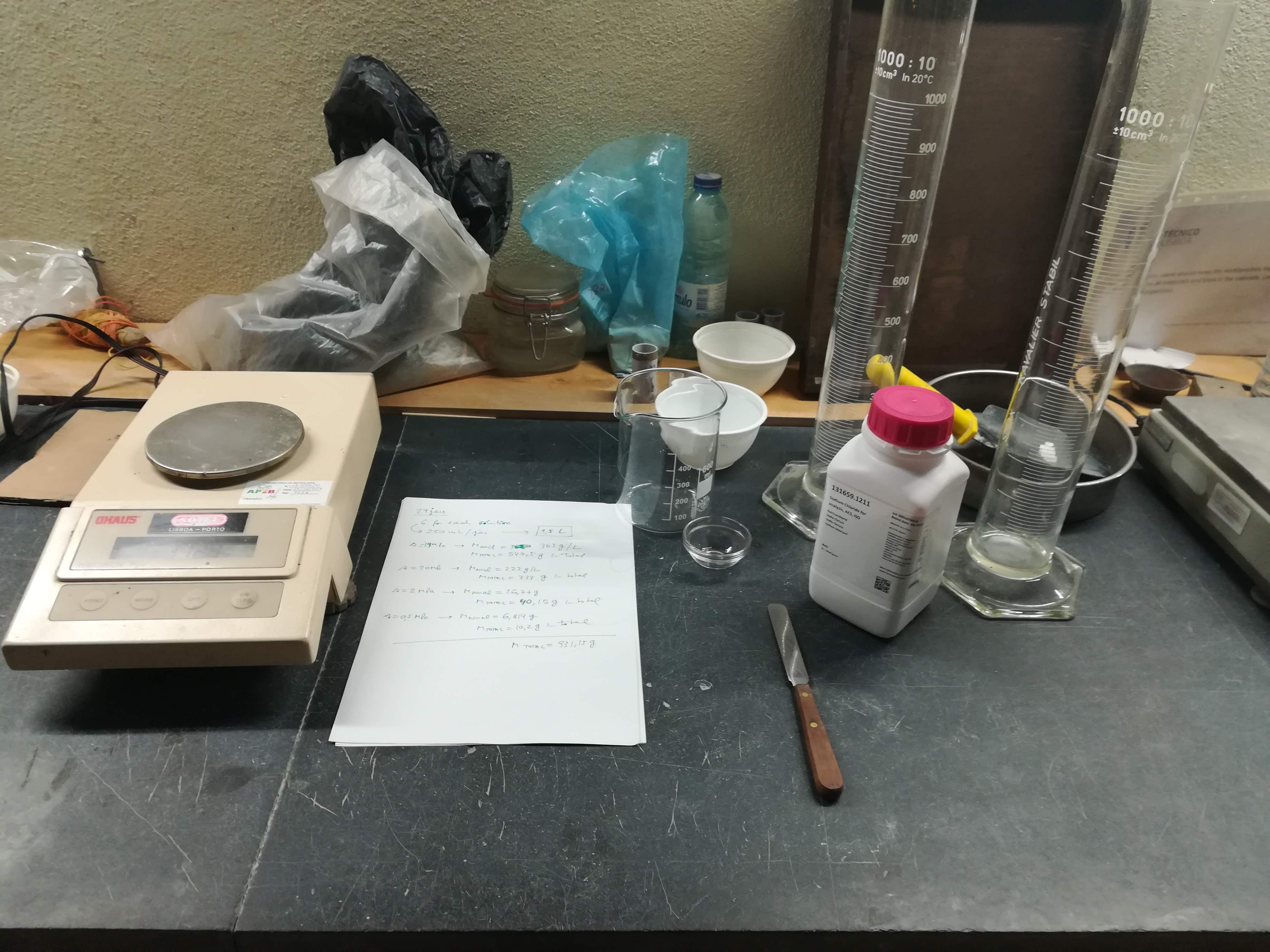

Vapour equilibrium test method (IST Lisbon)
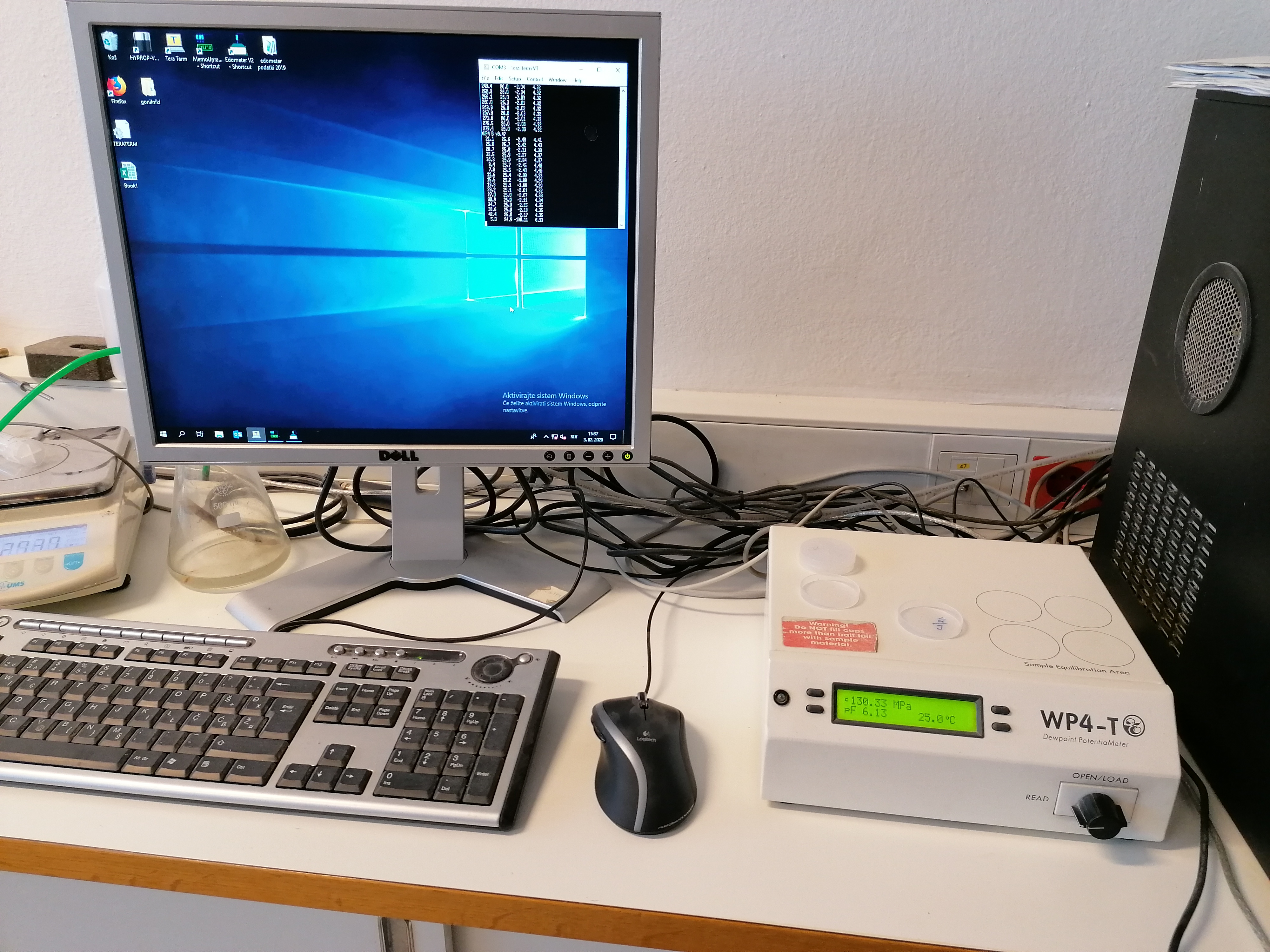
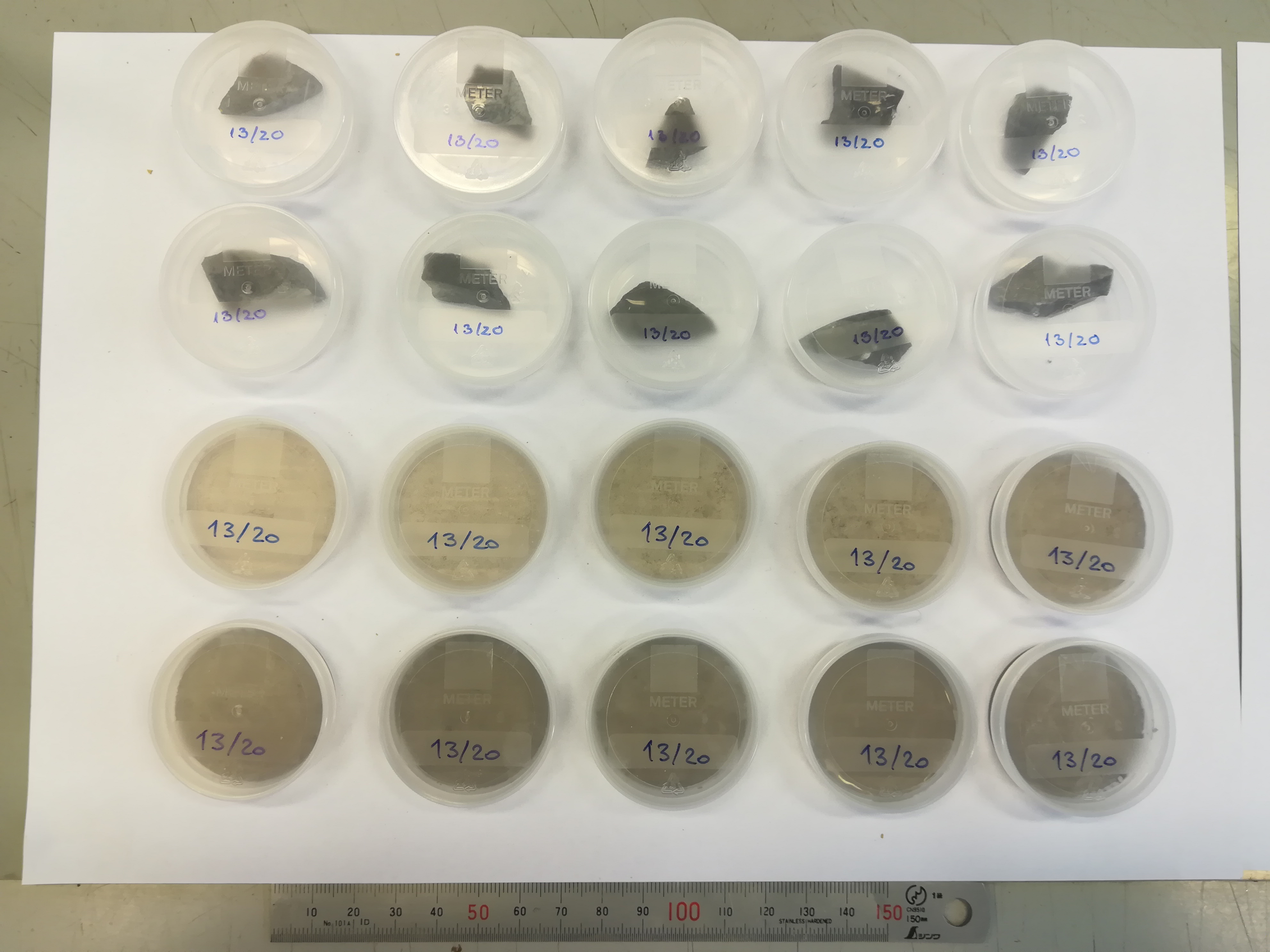
Suction measurement using WP4 apparatus - dewpoint method (FCGE Ljubljana)
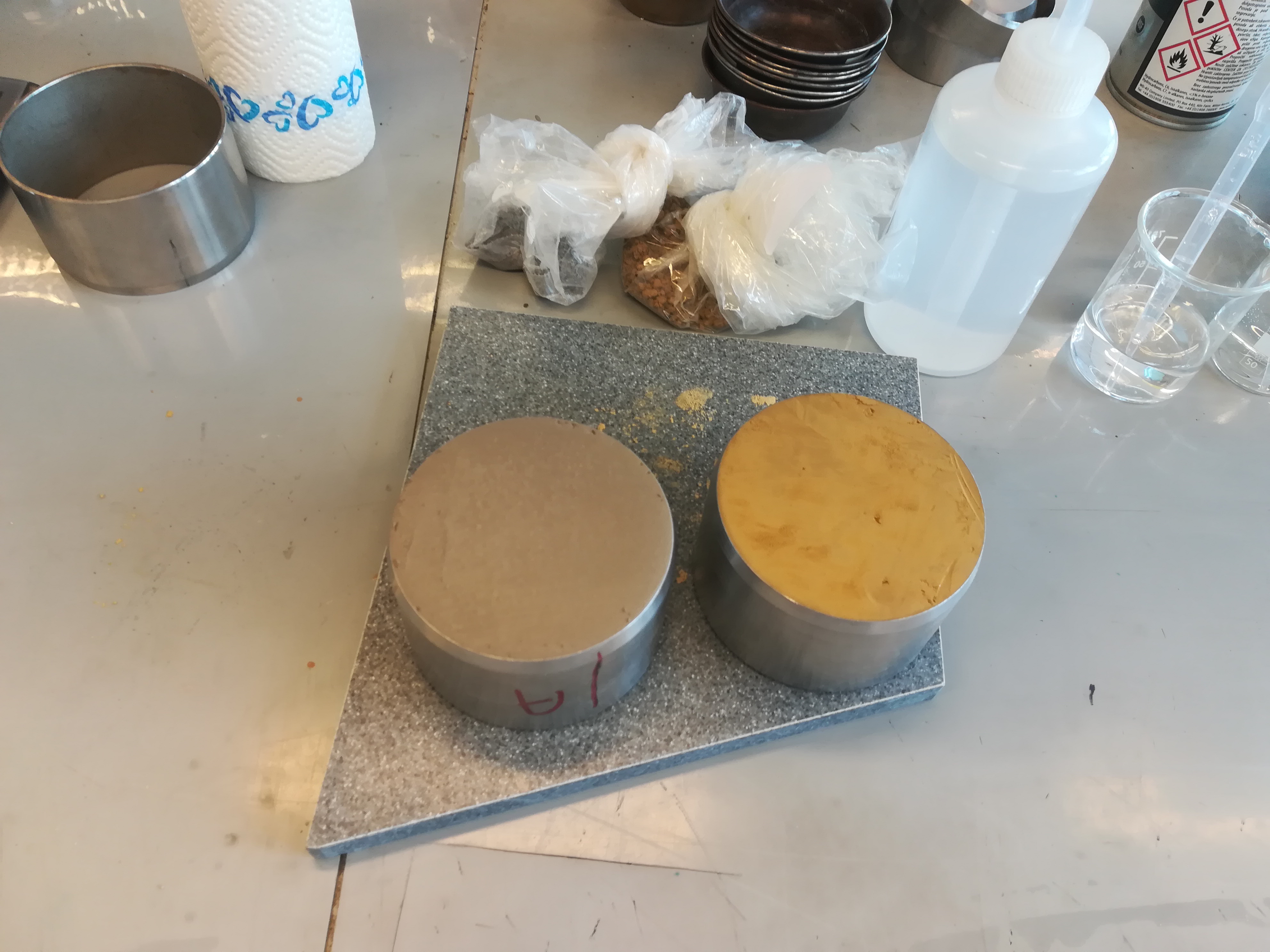
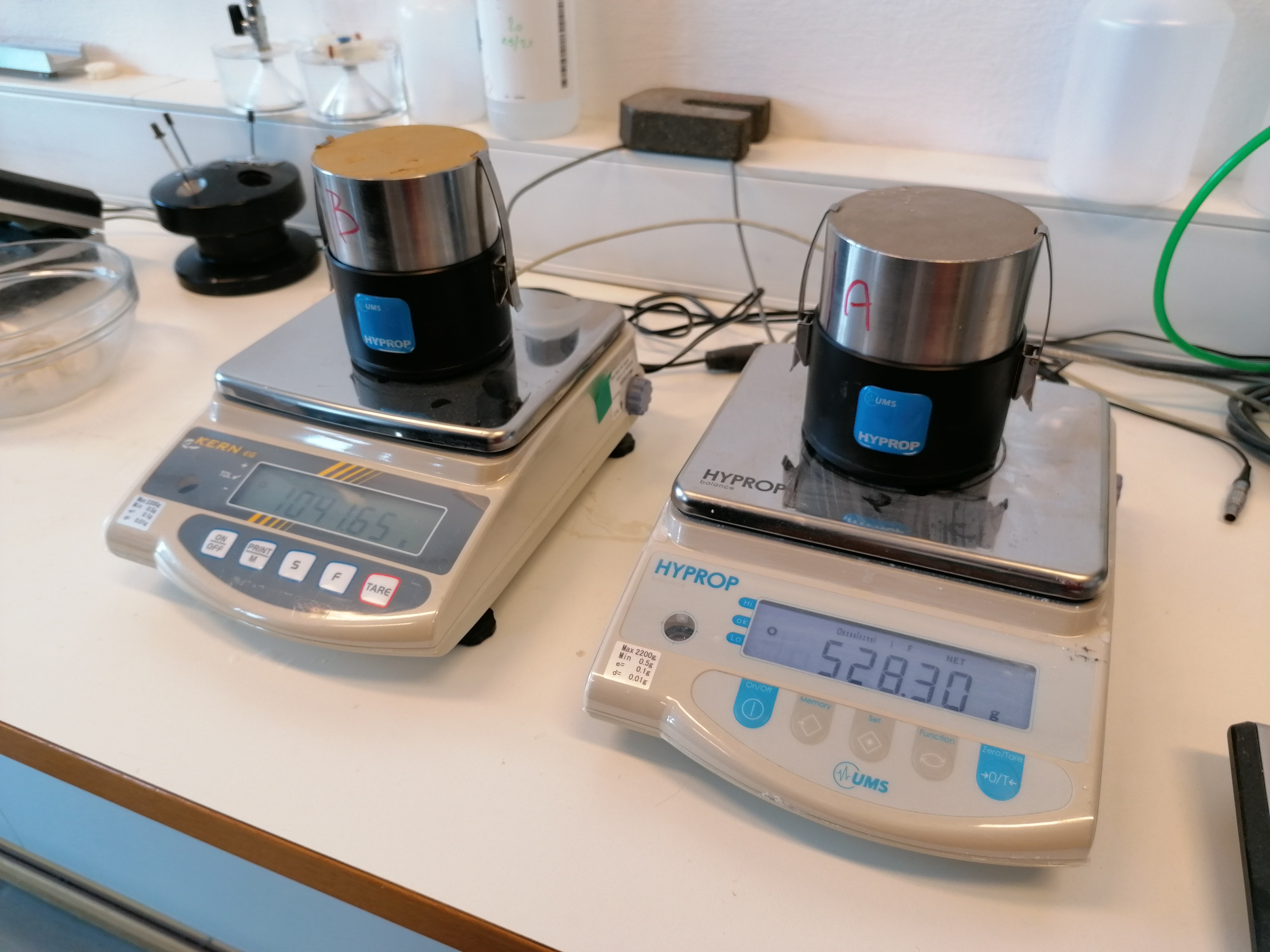
Suction measurement using HYPROP apparatus (FCGE Ljubljana)
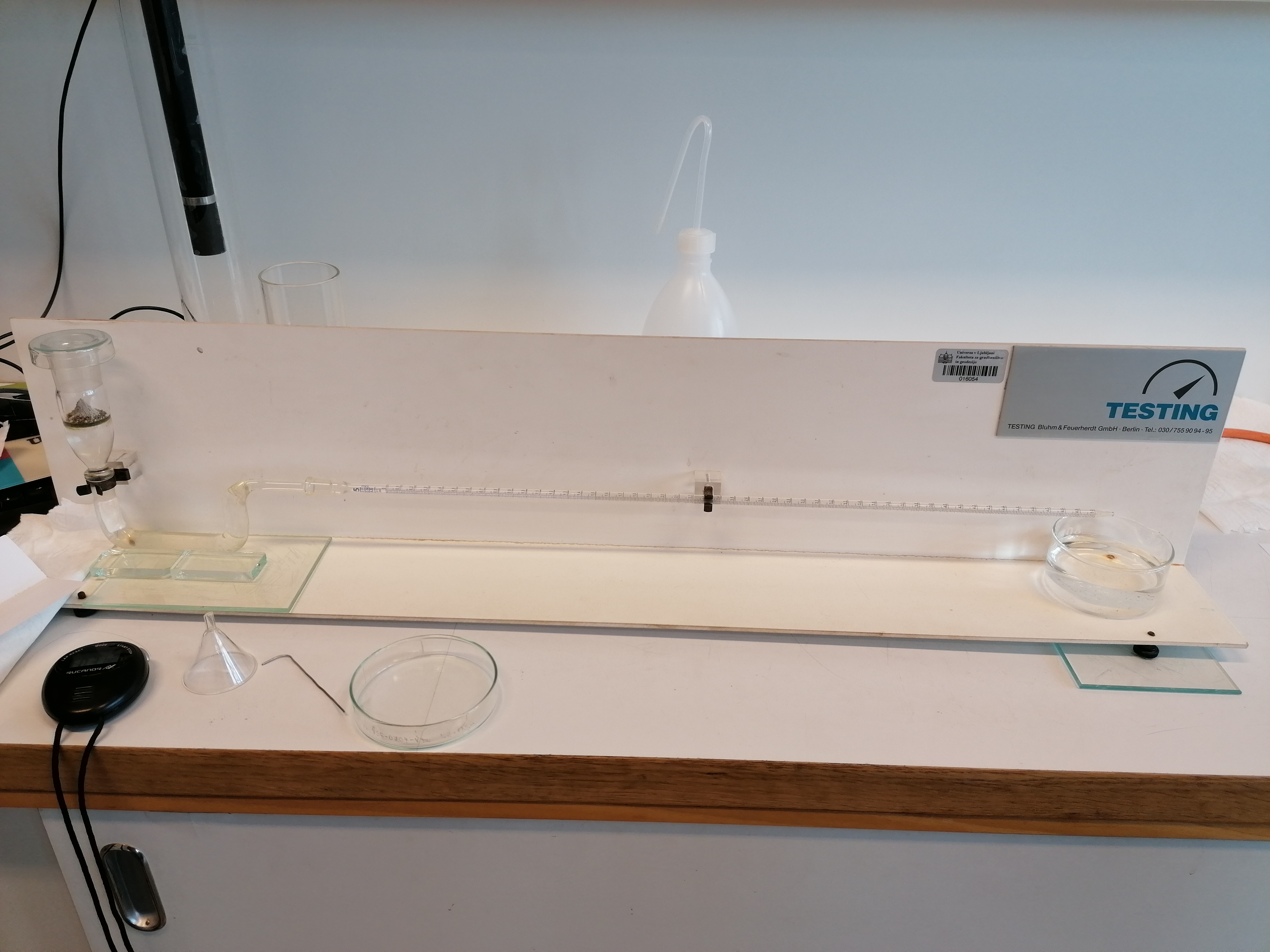
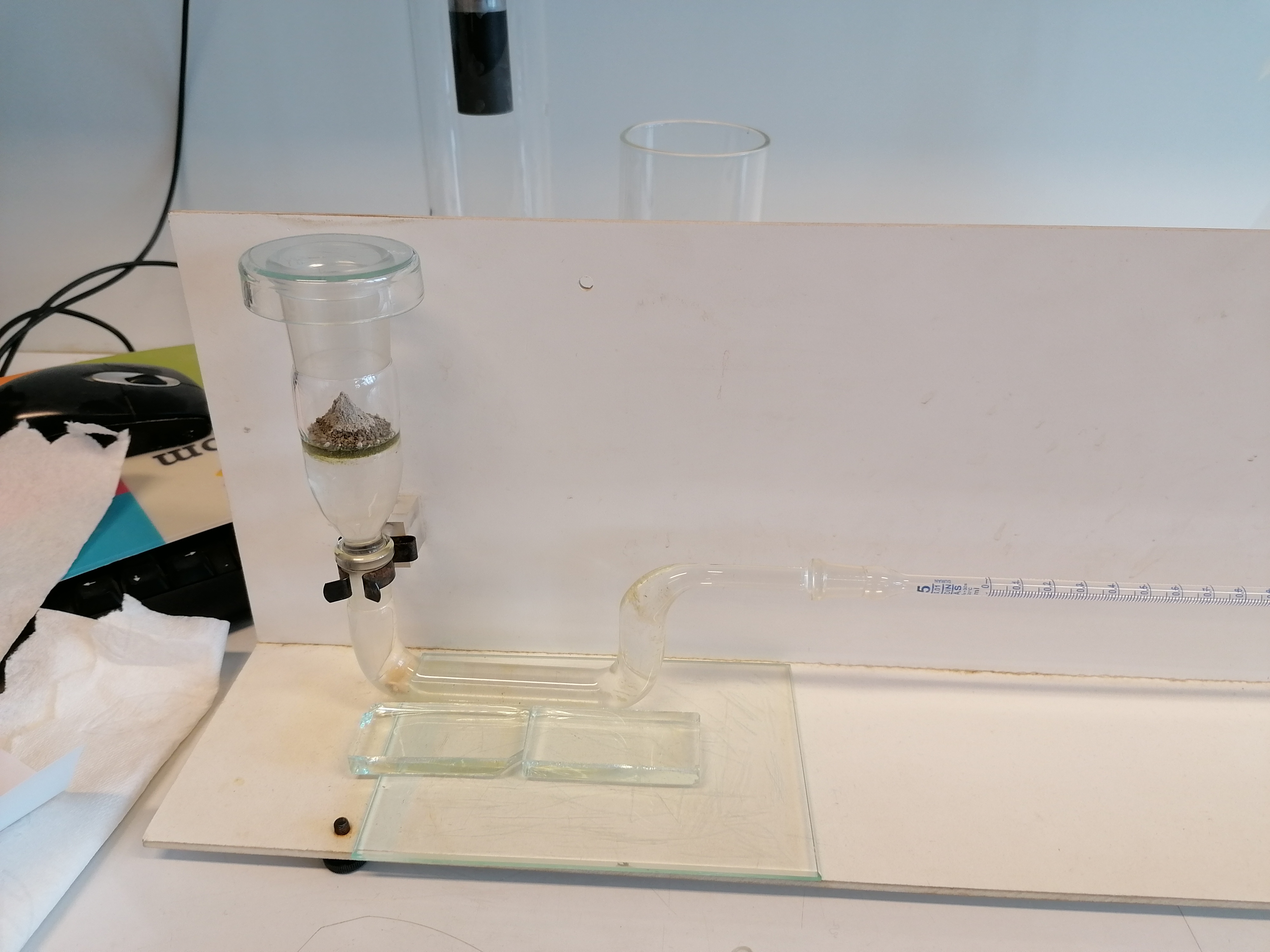
Determination of water adsorption capacity using Enslin-Neff test method (FCGE Ljubljana)

Equipment of the newly formed laboratory for testing of unsaturated geomaterials: a) automatic suction oedometer cell with HAEPD (High Air-Entry Porous Disc) 500 kPa (axis translation method), b) WP4C device (dew point method), c) DYNTTS – automatic static/dynamic triaxial system with unsaturated option (axis translation method), d) GDSBPS – automatic back pressurized shearbox device with unsaturated option (axis translation method), e) Enslin-Neff device (adsorption capacity measurement), f) methylene blue kit (estimation of small particles)
________________________
Any opinions, findings, and conclusions or recommendations expressed in this material are those of the author(s) and do not necessarily reflect the views of Croatian Science Foundation.